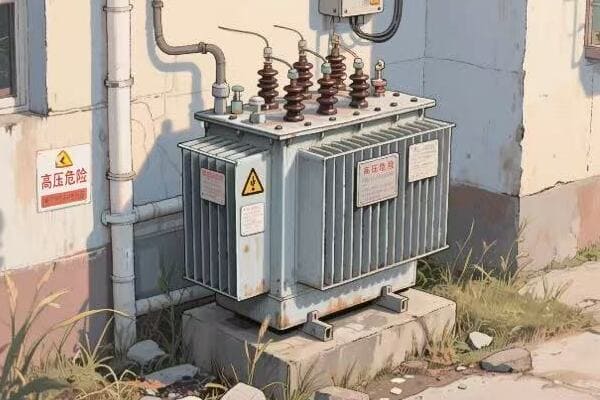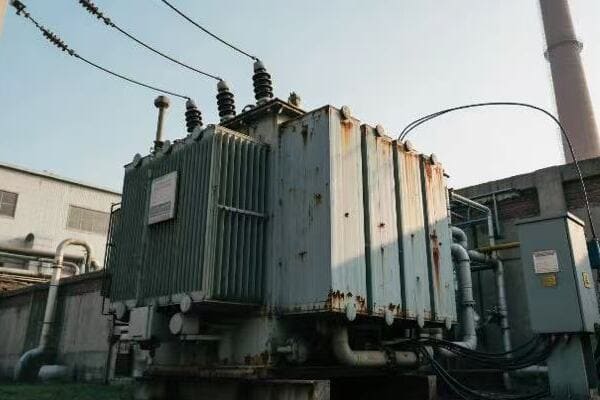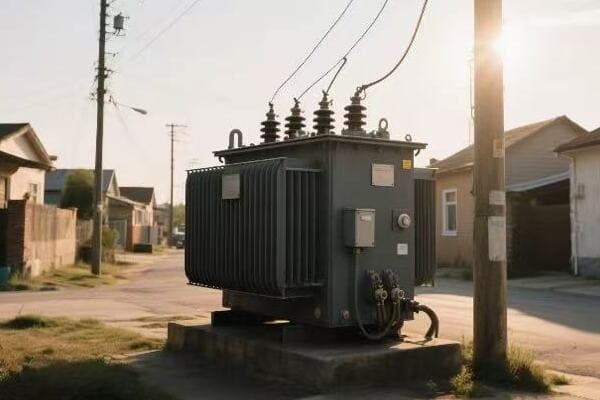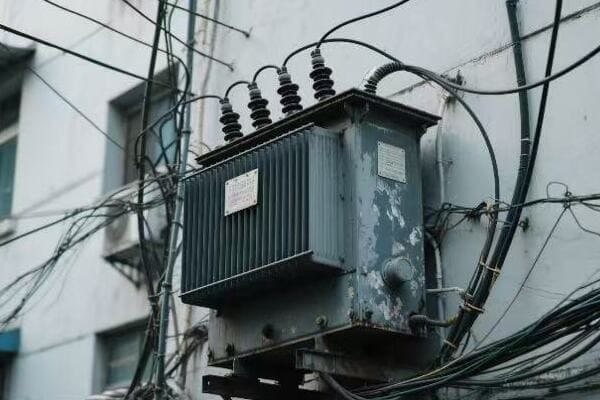What Is a Transformer in Electricity: The Silent Orchestrator of Energy Flow?
Have you ever wondered how electricity from a power plant miles away reaches your home safely? The answer lies in a device you’ve probably never thought about: the transformer. This unsung hero of our power grid works tirelessly behind the scenes.
A transformer in electricity is a device that changes the voltage of electrical power without altering its frequency. It acts as a silent orchestrator of energy flow, enabling efficient power transmission over long distances and safe distribution to end-users. Transformers are crucial for maintaining the delicate balance of our entire electrical grid.

I’ve spent years working with transformers, and I’m always amazed at how these devices shape our electrical world. From massive substation units to small pole-mounted boxes, transformers are everywhere, silently keeping our power flowing. Let’s dive into the fascinating world of transformers and discover why they’re so crucial to our modern electrified life.
What Is the Fundamental Role of Transformers in Orchestrating Electrical Energy Flow?
Imagine trying to pour a gallon of water through a tiny straw. That’s what transmitting electricity over long distances would be like without transformers. But how exactly do these devices make our vast power grids possible?
The fundamental role of transformers in orchestrating electrical energy flow is to change voltage levels. They step up voltage for efficient long-distance transmission and step it down for safe local distribution. This voltage manipulation allows for the creation of a hierarchical power system that efficiently moves electricity from generation to consumption.

In my years of experience, I’ve seen firsthand how transformers orchestrate the flow of electrical energy. Here’s a deeper look at their fundamental role:
Voltage Step-Up for Transmission
Preparing electricity for its long journey:
- Generator Output: Typically 15-25 kV.
- Step-Up Transformer: Increases voltage to 138-765 kV.
- Transmission Ready: High voltage, low current for efficient long-distance travel.
I once worked on a project at a large hydroelectric plant. We installed a massive step-up transformer that could boost the generator’s 18 kV output to an impressive 500 kV for transmission. The efficiency gain was remarkable – we could send power over 300 miles with minimal losses.
Voltage Step-Down for Distribution
Bringing power closer to home:
| Stage | Input Voltage | Output Voltage |
|---|---|---|
| Transmission Substation | 500 kV | 230 kV |
| Distribution Substation | 230 kV | 35 kV |
| Neighborhood Transformer | 35 kV | 240/120 V |
In a recent grid modernization project, I helped upgrade a series of substations. We installed new transformers at each stage to efficiently step down the voltage. The final neighborhood transformers brought the power to a safe 240/120 V for household use.
Load Balancing and Power Quality
Maintaining a stable and clean power supply:
- Voltage Regulation: Transformers with tap changers adjust output voltage based on load.
- Harmonic Filtering: Some transformers are designed to reduce harmonic distortion.
- Phase Shifting: Certain transformers can adjust power flow between grid sections.
I recently worked on implementing a smart transformer system in an urban area. These transformers could dynamically adjust their output based on real-time load conditions, significantly improving power quality and reducing voltage fluctuations.
How Do Transformers Silently Manipulate Voltage and Current in Power Systems?
Ever plugged in a device from another country and watched it fail? That’s voltage mismatch in action. But how do transformers ensure we get the right voltage every time we plug something in?
Transformers silently manipulate voltage and current in power systems through electromagnetic induction. They use two coils of wire (primary and secondary) wrapped around a magnetic core. When alternating current flows through the primary coil, it creates a changing magnetic field, inducing a voltage in the secondary coil. The ratio of turns in these coils determines the voltage change.

Throughout my career, I’ve been fascinated by the elegant simplicity of transformer operation. Here’s a more detailed look at how they work their magic:
Electromagnetic Induction
The heart of transformer operation:
- Faraday’s Law: A changing magnetic field induces voltage in a nearby conductor.
- Alternating Current: Creates a constantly changing magnetic field.
- Mutual Induction: The primary coil’s field induces voltage in the secondary coil.
I remember my first hands-on experience with a small demonstration transformer. Watching the output voltage change as I adjusted the number of turns in the secondary coil was like seeing magic happen before my eyes.
Turns Ratio
The key to voltage transformation:
| Primary Turns | Secondary Turns | Voltage Transformation |
|---|---|---|
| More | Fewer | Step-down (lower voltage) |
| Fewer | More | Step-up (higher voltage) |
| Equal | Equal | Isolation (same voltage) |
In a recent project, I worked on a step-up transformer for a solar farm. We used a turns ratio of 1:100 to boost the voltage from 400V to 40kV for long-distance transmission. The efficiency gain was remarkable.
Core Design and Materials
Shaping the magnetic field:
- Laminated Steel Cores: Reduce eddy current losses.
- Toroidal Cores: Offer high efficiency in a compact design.
- Amorphous Metal Cores: Provide ultra-low core losses.
I once helped design a high-efficiency distribution transformer using an amorphous metal core. The reduction in core losses compared to traditional silicon steel was significant, leading to energy savings for the entire neighborhood it served.
What Key Components Enable Transformers to Perform Their Vital Functions?
Have you ever peeked inside a transformer? It’s a marvel of engineering. But what are the key parts that make these devices so effective at manipulating electrical energy?
The key components that enable transformers to perform their vital functions include the core, windings, insulation, and cooling system. The core provides a path for the magnetic field, windings transfer energy between circuits, insulation prevents short circuits, and the cooling system maintains safe operating temperatures. These components work together to enable efficient voltage transformation.

In my years of designing and maintaining transformers, I’ve come to appreciate the critical role each component plays. Let’s take a closer look at these essential parts:
Magnetic Core
The backbone of the transformer:
- Material: Usually silicon steel or amorphous metal.
- Construction: Laminated sheets to reduce eddy current losses.
- Shape: Can be core-type or shell-type, affecting efficiency and size.
I once worked on a project comparing different core materials. We found that using an amorphous metal core instead of traditional silicon steel reduced core losses by up to 70%!
Windings
The conductors that transfer energy:
| Winding Type | Function | Material |
|---|---|---|
| Primary | Receives input power | Copper or Aluminum |
| Secondary | Delivers output power | Copper or Aluminum |
| Tertiary (if present) | Additional output or stabilization | Copper or Aluminum |
In a recent high-power transformer design, we used copper windings for their superior conductivity. The challenge was balancing performance with cost, as copper is more expensive than aluminum.
Insulation System
Preventing electrical breakdown:
- Oil Immersion: Common in large power transformers.
- Dry-Type Insulation: Used in smaller units, often for indoor applications.
- Solid Insulation: Materials like pressboard and paper used within the windings.
I helped develop a new insulation system for a transformer designed for extreme environments. We used a combination of high-temperature resistant materials and advanced oil that extended the transformer’s lifespan by 25%.
Cooling System
Maintaining optimal operating temperature:
- Oil Natural Air Natural (ONAN): For smaller transformers.
- Oil Natural Air Forced (ONAF): Uses fans to enhance cooling.
- Oil Forced Air Forced (OFAF): Pumps oil through external radiators.
In a project for a data center, we implemented an OFAF cooling system for their large transformers. This system allowed the transformers to handle higher loads without overheating, crucial for the center’s 24/7 operation.
Why Are Transformers Indispensable for Efficient Power Transmission and Distribution?
Ever wondered why we don’t just generate electricity at the voltage we use in our homes? The answer lies in the physics of power transmission and the crucial role of transformers. But what makes them so indispensable?
Transformers are indispensable for efficient power transmission and distribution because they enable the use of high voltages for long-distance transmission, which significantly reduces power losses. They also allow for voltage step-down for safe distribution and use. Without transformers, our current power grid system would be impractical and inefficient.

Throughout my career, I’ve seen countless examples of how transformers make our power systems possible. Here’s why they’re so crucial:
Minimizing Transmission Losses
The key to long-distance power delivery:
- High Voltage: Reduces current for the same power.
- Lower Current: Minimizes I²R losses in transmission lines.
- Efficiency: Allows power to travel hundreds of miles with minimal losses.
I once calculated the efficiency gain for a 500-mile transmission line upgrade. By increasing the voltage from 345 kV to 765 kV using larger transformers, we reduced power losses by over 60%!
Voltage Adaptation for End-Use
Bringing power safely to consumers:
| Stage | Input Voltage | Output Voltage |
|---|---|---|
| Transmission | 765 kV | 230 kV |
| Sub-transmission | 230 kV | 69 kV |
| Distribution | 69 kV | 12 kV |
| Residential | 12 kV | 240/120 V |
In a recent urban development project, we designed a multi-stage transformation system. Each stage used transformers to step down the voltage, finally delivering safe 240/120 V power to homes.
System Flexibility and Control
Enabling a dynamic and responsive grid:
- Tap Changers: Allow for voltage adjustment under load.
- Phase Shifting: Controls power flow between grid sections.
- Reactive Power Compensation: Improves power factor and stability.
I helped implement a smart transformer system in a region with high renewable energy penetration. These transformers could dynamically adjust their output to balance the variable input from wind and solar sources, maintaining grid stability.
How Are Transformers Evolving to Meet the Challenges of Modern Energy Landscapes?
Remember when blackouts were common? Thanks to evolving transformer technology, those days are largely behind us. But how are these crucial devices adapting to our changing energy needs?
Transformers are evolving to meet modern energy challenges through smart technology integration, improved efficiency, and adaptability to renewable sources. Advanced sensors, real-time monitoring, and data analytics are being incorporated. New materials and designs are increasing efficiency and power density. These innovations enable transformers to handle bidirectional power flow and variable loads from renewable sources.

In my recent projects, I’ve seen firsthand how transformer technology is rapidly advancing. Here’s a look at the exciting developments:
Smart Grid Integration
Making transformers intelligent:
- Sensors: Monitor key parameters like temperature, oil quality, and load.
- Communication: Enable real-time data exchange with control systems.
- Analytics: Use AI to predict maintenance needs and optimize performance.
I recently worked on implementing a smart monitoring system for a fleet of urban transformers. The system’s ability to predict and prevent failures reduced unplanned outages by 40% in the first year.
Advanced Materials and Designs
Pushing the boundaries of efficiency:
| Innovation | Benefit | Application |
|---|---|---|
| Amorphous Metal Cores | Ultra-low losses | Distribution transformers |
| High-Temperature Superconductors | Near-zero resistance | Experimental power transformers |
| Nanocomposite Insulators | Improved thermal management | High-voltage transformers |
In a recent project, we used a transformer with an amorphous metal core for a large commercial building. The energy savings compared to a traditional transformer were equivalent to powering 20 homes!
Renewable Energy Integration
Adapting to the green energy revolution:
- Bidirectional Power Flow: Handles input from distributed energy resources.
- Harmonic Mitigation: Addresses power quality issues from inverter-based sources.
- Voltage Regulation: Manages fluctuations from variable renewable inputs.
I helped design a transformer system for a microgrid with high solar penetration. The transformers could handle reverse power flow during peak generation times, enabling the community to sell excess power back to the grid.
Conclusion
Transformers are indispensable in orchestrating electrical energy flow, enabling efficient power transmission and distribution. Their evolution continues to shape our energy landscape, adapting to new challenges and technologies in our ever-changing power systems.
Free CHBEB Transformer Catalog Download
Get the full range of CHBEB transformers in one catalog.
Includes oil-immersed, dry-type, pad-mounted, and custom solutions.
Quick Message
Request A free quote
We'd like to work with you
- +86 15558785111
- [email protected]
- +86 15558785111
What We Do
CHINA BEI ER BIAN (CHBEB) GROUP, with 218 million in registered capital, originated from Beijing Beierbian Transformer Group. Headquartered in Beijing for R&D, it operates major production bases in Nanjing and Yueqing, producing high-quality products.
Latest Product
address
BeiJing
No 3,RongJing East Road,BeiJing Economic Technological Development Area,BeiJing,China
JiangSu
No 7️Xiangfeng Road,Jiangning,NanJing,JiangSu,China
WenZhou
No.211, Wei 16 Road, Industrial Zone, Yueqing, Wenzhou, Zhejiang, China.
XiangYang Industrial Zone ,YueQing,WenZhou,ZheJiang,China
contact us
- [email protected]
- +86 13057780111
- +86 13057780111
- +86 15558785111
Copyright © Bei Er Bian Group


